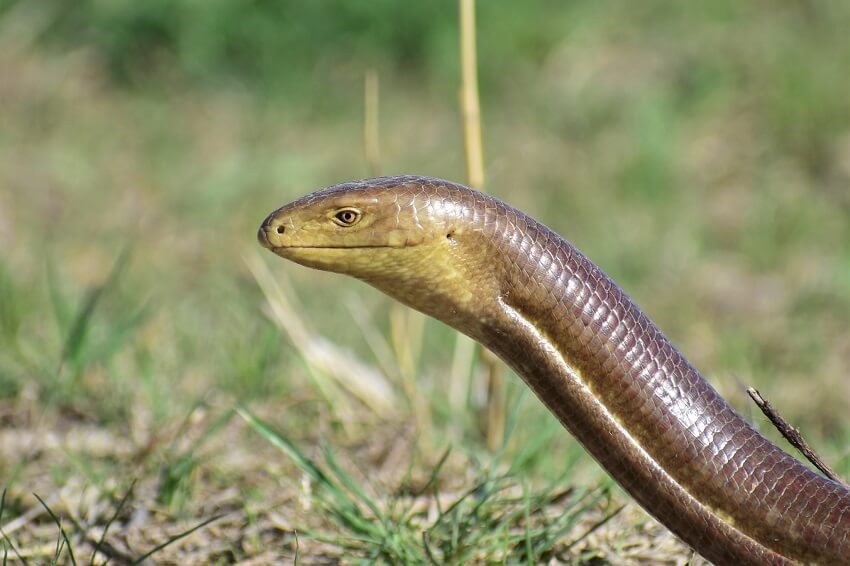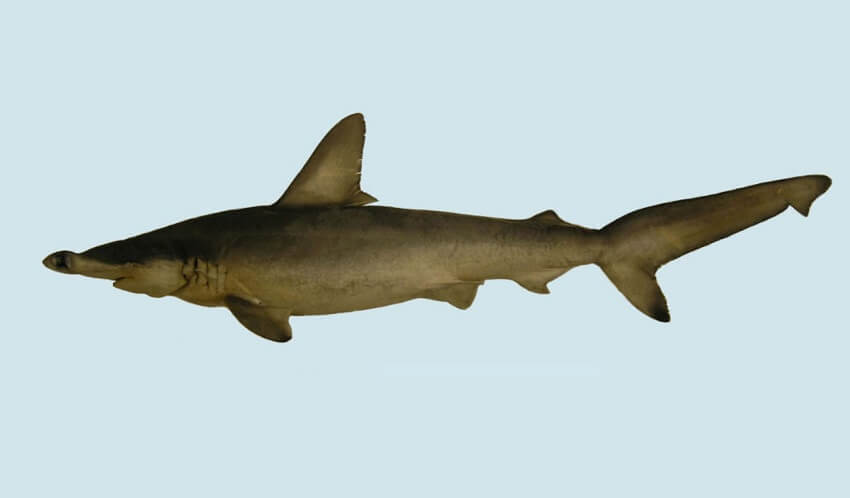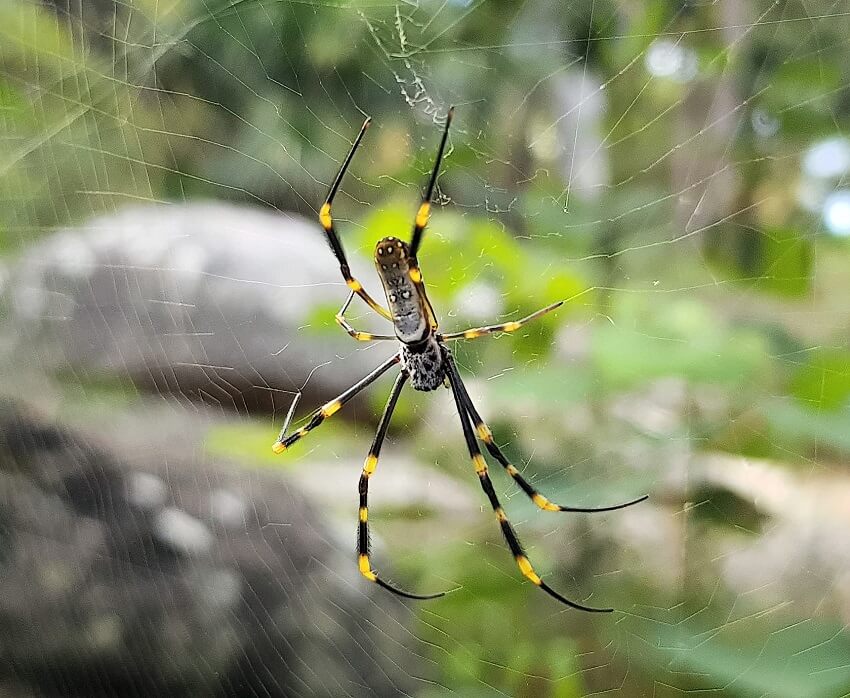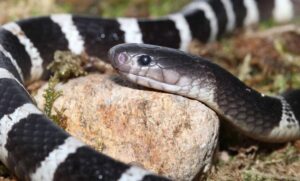Tiger moths, Cambodian tailorbirds, and Epaulette sharks are all animals that have only been discovered in recent years, despite having existed on Earth for a long time. If you also want to discover some Newly Discovered Animals, join KnowAllAnimals to find out more in the following article. Let’s go!
1. Top 10 Newly Discovered Animals You Won’t Believe Exist
Discover the top 10 newly discovered animals with such unique and incredible appearances and characteristics that you won’t believe they exist. These creatures not only surprise the scientific community but also reveal fascinating mysteries about the natural world.
1.1. Legless Lizard
The legless lizard was discovered at Los Angeles International Airport in the U.S. They differ from snakes in several ways, such as the ability to detach their tails to escape in emergencies. They also have eyelids, which snakes don’t, and a rigid jaw that is not as flexible as a snake’s. Legless lizards are descendants of regular four-legged lizards, while snakes evolved from a very rare four-legged lizard species.

1.2. Epaulette Shark
The Epaulette Shark was discovered in Indonesia and typically lives in shallow waters on the seabed. Instead of swimming, they “walk” by wiggling their bodies and pushing with their paddle-shaped fins. This species has evolved to be active at night; they can increase blood flow to their brains and shut down non-essential neurological functions, which allows them to survive for hours without oxygen.
1.3. Olinguito
The Olinguito is a new mammal species in the raccoon family that was discovered by Kristofer Helgen in August. The Olinguito weighs an average of about 900 grams (2 lbs), typically eats fruit and insects, and lives in the forests of the Andes Mountains in Ecuador and Colombia. Its name comes from the Spanish for “little olingo,” because it has a similar appearance to the olingo but is smaller in size. The Olinguito was mistaken for the olingo species for many years.
1.4. Boki Mekot Rat
Scientists discovered the Boki Mekot Rat while exploring Halmahera Island in Indonesia. This rodent is small, with gray-brown fur, a white belly, and a white spot at the end of its tail. Initial studies show that it is an omnivore and has the DNA characteristics of animals that migrated from the West to Asia.

1.5. Oreophryne Frog
Three new frog species belonging to the genus Oreophryne—Oreophryne cameroni, Oreophryne parkopanorum, and Oreophryne gagneorum—were discovered in Papua New Guinea. There are now seven species of Oreophryne frogs, each measuring only 20 mm (0.8 inches) in size. Researchers believe that there may still be many more new creatures yet to be discovered in this region.
1.6. Harp Sponge (Chondrocladia lyra)
The Harp Sponge (Chondrocladia lyra), also known as the lyre sponge due to its harp-like shape, was discovered in the seas off the coast of California, U.S., using an autonomous underwater vehicle. Unlike other sponges that feed on bacteria or organic matter, Chondrocladia lyra is a carnivorous sponge. This species has long tendrils extending from a central vein, and small barbs on the tendrils are used to trap passing fish, after which the sponge envelops the prey in a thin membrane and gradually digests it.
1.7. Carolina Hammerhead Shark
The Carolina Hammerhead Shark was discovered in 2006 but was not officially named until this year. This shark species was named after the area where it was found: the waters off the coast of South Carolina, U.S. The main feature that distinguishes it from other sharks is the number of vertebrae. Scientists believe this shark is common worldwide but is difficult to identify because its migration patterns are still a great mystery.

1.8. Cambodian Tailorbird
The Cambodian Tailorbird is a small bird with an orange-red tuft on its head that was discovered in the capital city of Phnom Penh. Its name, “Tailorbird,” comes from the meticulous way these birds weave leaves together to build their nests. This species has a similar appearance to common tailorbirds, but after studying its feathers, DNA, and song, scientists concluded that it is a new species. The Cambodian Tailorbird is currently on the endangered species list because its habitat is shrinking.
1.9. Type D Killer Whale
The killer whale is the largest member of the oceanic dolphin family and also the most aggressive carnivorous whale in the ocean. To date, scientists have discovered and recognized three species of killer whales worldwide. This is the fourth killer whale species to be discovered, found in the southern Indian Ocean. The distinguishing features of this new species include differences in its behavior, eating habits, genetic sequence, and the shape of its small head with a small white patch near its eye.
1.10. Tiger Spider
The new Tiger Spider (Poecilotheria) species, scientifically named Poecilotheria rajaei, was discovered in northern Sri Lanka. This new spider species measures about 20 cm (8 inches), with gray and yellow stripes along its legs and body. Previously, these spiders lived on trees, but since an increase in deforestation has destroyed their natural habitat, they have begun to move into abandoned old buildings.

2. FAQs
1. What reptile was discovered near Los Angeles Airport?
The legless lizard was discovered right at Los Angeles International Airport. This reptile is different from a snake because it has eyelids, a rigid jaw, and the ability to detach its tail to escape when in danger.
2. What is special about the way the Epaulette Shark moves?
The Epaulette Shark lives in the shallow waters of Indonesia. Instead of swimming, it “walks” by using its paddle-like fins to wiggle between rocks. It also has the ability to temporarily shut down certain functions to survive in low-oxygen conditions.
3. What new raccoon species was recently identified and where does it live?
The Olinguito, a species in the raccoon family, was discovered in the Andes forests of Ecuador and Colombia. It was previously mistaken for an Olingo but is smaller, weighing about 900 g (2 lbs).
4. What are the origins and notable characteristics of the Boki Mekot Rat?
This rat species was found on Halmahera Island, Indonesia. The Boki Mekot Rat has gray-brown fur, a white belly, and a notable white spot at the tip of its tail. DNA analysis shows it has a mixed origin from Western animals that migrated through Asia.
5. What recently discovered sponge species is unique?
The Harp Sponge (Chondrocladia lyra) was discovered off the coast of California. It is a carnivorous sponge that has long tendrils and small barbs used to trap and gradually digest fish.
3. Conclusion
The discovery of Newly Discovered Animals like the legless lizard, Epaulette shark, Olinguito, Boki Mekot rat, and Harp Sponge not only reveals bizarre new aspects of the natural world but also reminds us that Earth’s biodiversity is far from fully explored. Every new species reveals another part of the story of evolution, adaptation, and nature’s mysteries. Join Know All Animals in appreciating and protecting the valuable insights that each new discovery brings.



